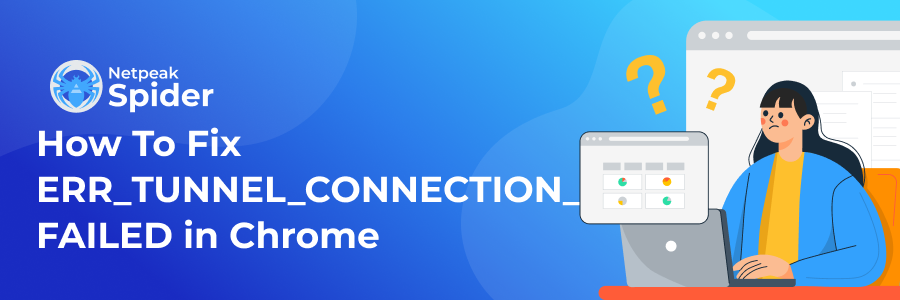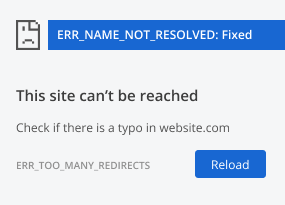What is ERR_TUNNEL_CONNECTION_FAILED and How to Fix it
Site Audit Issues
The "err tunnel connection failed" error occurs for several reasons. This is a common thing Google Chrome users stumble upon from time to time. What factors can cause this, and how can this issue be fixed efficiently? This post will cover all this and show you how to use Netpeak Spider to prevent this error from reappearing.
What is the ERR_TUNNEL_CONNECTION_FAILED issue?
A tunnel-type connection allows secure data transmission over the network. The ERR_TUNNEL_CONNECTION_FAILED error signals about an issue with your proxy or a Domain Name System (i.e., DNS). It doesn’t mean there's a problem with your internet connection; it's just that the DNS or proxy may fail to resolve the domain you’re attempting to visit. This is typically a problem Google Chrome users stumble upon.
However, you should remember that the "tunnel connection failed" message is quite generic and may not reflect the real issues behind it. Hence, you need to find a trigger first and then apply an appropriate solution. Here are some of the main factors that can cause trouble:
- Wrong domain configuration of a website;
- Conflicting browser data;
- DNS connection issues;
- Incorrect proxy settings.
Best ways to fix the ERR_TUNNEL_CONNECTION_FAILED error
Now that you know what "err connection failed" means, let's find out how to troubleshoot it. There are four most efficient ways to detect and fix the error triggers. Before you start, it's better to clear the browser's cache.
Check the proxy settings and disable them if needed
In most cases, proxy-related issues cause the ERR_TUNNEL_CONNECTION_FAILED error. To fix this, try configuring the OS to either automatically detect proxy settings or use a specific server.
If you're a Windows user, type in inetpl.cpl in the command prompt to access Internet Properties. There, go to Connections and then LAN Settings. Now, you can check if Windows is using a specific proxy. If yes, then look up the server information under Proxy. The internet connection should, by default, automatically detect proxy settings. Try enabling it for some time if you see it's off.
After that, check once again if the ERR_TUNNEL_CONNECTION_FAILED error message disappeared. If it hasn't, turning off both the automatic and the manual setups can help, and you'll be browsing the web without a proxy.
If you’re a macOS user, go to System Settings and then Network to pick a network service. Click on Details, then Proxies. Here, try turning off both automatic and manual setups and check if the error still persists. If it does, it's time to try the next step.
Reset the internet settings
At this point, you renew the IP address and clear the local DNS cache of your computer. On a Windows PC, enter the command prompt as an administrator and type in the following commands individually.
IPCONFIG /FLUSHDNS
NBTSTAT –R
NETSH INT IP RESET
NETSH WINSOCK RESET
Press Enter to run one command at a time. After the last one is done, restart the browser. If you still can see the "err connection failed" error, there must be an issue with the DNS configuration.
Speaking of macOS, Apple doesn’t provide a network resetting function, yet you can try deleting and re-adding your Wi-Fi network (or wired connection) as an option.
Change the DNS server
Your OS uses the default DNS server provided by your Internet Service Provider (ISP), but you can also make your system start using another specific DNS.
If you receive the "tunnel connection failed" error message, your DNS configuration might be causing the trouble. On your Windows PC, go to the Network status screen and pick Advanced network settings, then Change adapter options — this will help you check if the reason is really the DNS.
Then, find an active network connection, right-click on it, and select Properties. In a popup that appears afterward, select Internet Protocol Version 4 (TCP/IPv4) and click Properties.
This window will let you manage the IP and DNS settings for an active internet connection. By default, both an IP address and the DNS servers will be obtained automatically. If that's the case, using a public DNS is better. In some cases, this approach can even enhance your page's loading time.
To start using a public DNS, enter the server address together with an alternate one. If you’re already utilizing a custom DNS, configure the connection to automatically obtain a DNS server.
Now you can refresh the browser, and if the ERR_TUNNEL_CONNECTION_FAILED error disappeared, there might be a temporary DNS-related problem.
Reset Chrome's settings
Chrome lets you reset the browser to default settings without reinstalling it. If none of the proxy and DNS configuration edits helped fix the ERR_TUNNEL_CONNECTION_FAILED error, this might be the right solution.
Go to Chrome's settings, click Reset, and clean up the tab. Next, choose to restore the Restore settings to their original configuration. Confirm the request.
Finally, click Reset and wait for Chrome to restart. Then, check if the error disappeared. If you can still see the error message, check if other browsers (e.g., Opera) show a connection error, too. If yes, the problem is likely not proxy- or DNS-related. This means you’ll have to return to the previous methods and make sure you've done everything right.
Where else can you stumble upon the “ERR_TUNNEL_CONNECTION_FAILED” error
The "err failed" issue is initially the one only Google Chrome can experience. Yet, several proxy and DNS-related issues can occur in other browsers, too. For instance, there's a "DNS Server Not Responding" issue that affects not only Chrome but also Safari, Edge, and Firefox.
Speaking of proxy errors, the “407 Proxy Authentication Required” is one you might encounter, too. In a nutshell, this error signals malfunctioning proxy credentials or their improper configuration.
Run in-depth website checkups with Netpeak Spider
One of the key solutions to DNS or proxy-related issues with a target website is running constant checkups. They help quickly detect and prevent problems that can drastically harm your online reputation and ruin the trust of your potential and current clients.
To help you avoid all that, Netpeak Spider comes to help. This powerful website crawler runs in-depth SEO analyses in just a few moments. Thanks to this app, you can track your website's metrics in real time, extract data from Google Analytics and Search Console, and, overall, detect over 100 known website-related issues.
Thanks to an interactive dashboard, you can monitor and store your research data and then download it in a convenient PDF format for your further SEO needs and tasks.
One of the most pleasant things about Netpeak Spider is that it's elementary to work with. All it takes is just several quick steps before you receive your website's checkup results:
- Gather all the URLs you need to analyze in a convenient list and upload it into Netpeak Spider; alternatively, you can simply paste this list from a clipboard into the app's search bar;
- On the right sidebar, check all the parameters you want to analyze;
- Click "Start" to launch the crawling process.
You can get a free trial of the app first to check its functions and built-in features. It's now available for both Windows and macOS users so that you can work with it on any preferred OS.
Final thoughts
"Google Chrome unable to connect to proxy server" — that's the error you may encounter as a Chrome user if there are any DNS or proxy-related issues out there. However, this is a treatable issue, especially if you manage to run regular website audits to see how well it performs and whether any critical problems require an instant fix.
For this purpose, you should try Netpeak Spider — this multifunctional website crawler won't just detect all possible website errors. This handy tool will also provide some useful troubleshooting tips and explain the potential threats each one of the detected errors carries. Use this tool for your daily SEO needs and improve your website's online performance right away!


.png)
